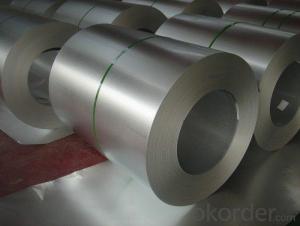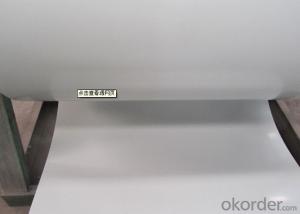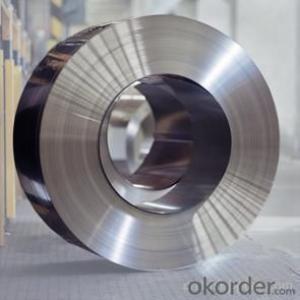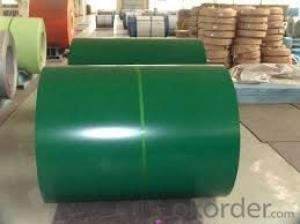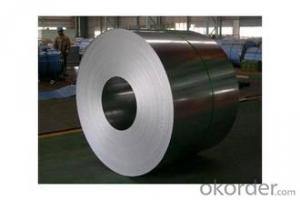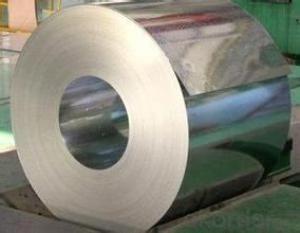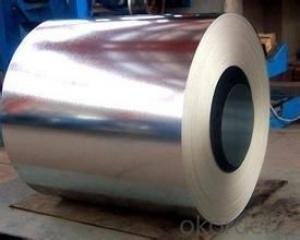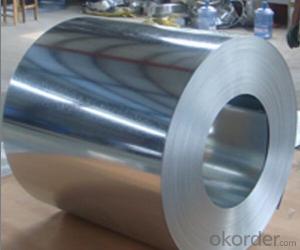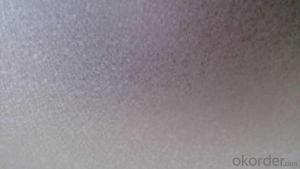Hot-Dip Galvanized/Aluzinc Steel Coil in Competitive Price and High Quality
- Loading Port:
- Shanghai
- Payment Terms:
- TT OR LC
- Min Order Qty:
- 100 m.t.
- Supply Capability:
- 10000 m.t./month
OKorder Service Pledge
OKorder Financial Service
You Might Also Like
Hot-dip Zinc Coating Steel Building Roof Walls
1.Structure of Hot-Dip Galvanized Steel Sheet Description:
Hot-dip galvanized steel coils are available with a pure zinc coating through the hot-dip galvanizing process. It offers the economy, strength and formability of steel combined with the corrosion resistance of zinc. The hot-dip process is the process by which steel gets coated in layers of zinc to protect against rust. It is especially useful for countless outdoor and industrial applications. Production of cold formed corrugated sheets and profiles for roofing, cladding, decking, tiles, sandwich walls, rainwater protective systems, air conditioning duct as well as electrical appliances and engineering.
2.Main Features of the Hot-Dip Galvanized Steel Sheet:
• Excellent process capability
• Smooth and flat surface
• Workability, durability
• Excellent anticorrosive property
• High strength
• Good formability
• Good visual effect
3.Hot-Dip Galvanized Steel Sheet Images

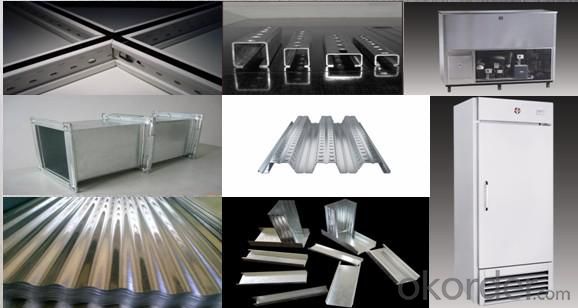
4.Hot-Dip Galvanized Steel Sheet Specification
Standard: ASTM, JIS,EN
Grade: CS, DX51D+Z,SGCC, SS 230~550,S220GD+Z~S550GD+Z, SGC340~SGC570
Thickness: 0.1mm~5mm
Width: max 2000mm
Coil weight:3-12 MT
Coil ID:508/610mm
Surface structure: zero spangle, regular spangle or minimum spangle
Surface treatment: Chromate treatment, Oiled/dry, skinpassed/non-skinpassed
Packing: Standard seaworthy export package
Technology test results:
| Processability | Yield strength | Elongation % | Elongation % | 180°cold-bending |
| Common PV | - | 270-500 | - | d=0,intact,no zinc removal |
| Mechanical interlocking JY | - | 270-500 | - | d=0,intact,no zinc removal |
| Structure JG | >=240 | >=370 | >=18 | d=0,intact,no zinc removal |
| Deep drawn SC | - | 270-380 | >=30 | d=0,intact,no zinc removal |
| EDDQ SC | - | 270-380 | >=30 | d=0,intact,no zinc removal |
5.FAQ of Hot-Dip Galvanized Steel Sheet
We have organized several common questions for our clients,may help you sincerely:
1.How about your company?
A world class manufacturer & supplier of castings forging in carbon steel and alloy steel,is one of the large-scale professional investment casting production bases in China,consisting of both casting foundry forging and machining factory. Annually more than 8000 tons Precision casting and forging parts are exported to markets in Europe,America and Japan. OEM casting and forging service available according to customer’s requirements.
2.How to guarantee the quality of the products?
We have established the international advanced quality management system,every link from raw material to final product we have strict quality test;We resolutely put an end to unqualified products flowing into the market. At the same time, we will provide necessary follow-up service assurance.
3. How long can we receive the product after purchase?
Usually within thirty working days after receiving buyer’s advance payment or LC. We will arrange the factory manufacturing as soon as possible. The cargo readiness usually takes 15-30 days, but the shipment will depend on the vessel situation.
- Q: Can steel coils be used in the production of aerospace components?
- Indeed, the utilization of steel coils is feasible for the manufacturing of aerospace components. Steel, being a robust and adaptable substance, possesses an outstanding ratio of strength to weight, rendering it appropriate for a multitude of purposes in the aerospace sector. The processing and manipulation of steel coils allow for the fulfillment of precise specifications, including the creation of intricate components, structural elements, and even utilization in aerospace engines. Moreover, the corrosion resistance characteristics and capability to endure extreme temperatures make steel a dependable selection for aerospace applications.
- Q: What are the different types of steel coil coatings available?
- There are several different types of steel coil coatings available, including galvanized, galvalume, and organic coatings. Galvanized coatings are made by dipping the steel coil in a bath of molten zinc, providing excellent corrosion resistance. Galvalume coatings, on the other hand, consist of a combination of aluminum and zinc, offering enhanced corrosion protection and heat resistance. Organic coatings, such as polyester, polyvinylidene fluoride (PVDF), and silicone-modified polyester (SMP), are applied to steel coils using a roll coating process, providing a wide range of color and aesthetic options, as well as additional protection against weathering and UV radiation.
- Q: I want to get a new knife but i cant decide if i wan a spyderco pacific salt or a cold steel ak47
- Given okorder / but always shop around and try Ebay...
- Q: I have a steel support beam can you remove one of the poles . the steel beam set on sender blocks on both side of the foundation. I have three steel beams support beam across the basement,I just want to remove one pole, can that be done.
- There's no way I am giving advice here. Hire a contractor to actually look at the load bearing of the pole.
- Q: How do steel coils contribute to energy efficiency in transportation?
- Steel coils are essential in energy-efficient transportation due to their lightweight yet strong nature. The use of steel coils in vehicles, such as cars and trucks, reduces the overall weight of the vehicle, enhancing fuel efficiency and reducing carbon emissions. Additionally, steel coils are often used in rail transportation, where their durability and strength contribute to the energy efficiency of trains by allowing for higher speeds and improved load carrying capacity.
- Q: Also, what is the top best slow cooker that is 100% stainless steel? Thank you!
- My SS pans are Prestige.
- Q: I play the guitar and recently found a new type of a guitar called the steel guitar, I don't want to play it or anything it's just I've never seen anything like it before and wonder what the function of it is and what are the differences to a classical guitar
- Different okorder /. If you just like the sound, take a serious look into slide guitar, not the same, but seriously tasty.
- Q: case hardening steel is adviced or thru hardening steel is most suitable?
- I don't know your application, but here is some advice. Case hard provides a hard shell around soft steel, depending on the bake, the case is usually .002-.008 thick. (thousands of an inch) Heat treated steel or tool steel is hard all the way thru. Case hardening, provides toughness with flexibility, however, once it's compromised, the part is scrap. Hardend tool steel is extreemly hard throughout and the harder it is, the more brittle it becomes. The application of the part will help you to determine the material needed. For instance; Plastic injection molds are very hard so the hot plastic wont erode them over years of use. Punch Press dies aren't as hard but are tougher to withstand the shock. Machine bolts are case hardened so they can last, but soft enough to allow some stretching during tightening. Either way, the time in mfg will be about the same. Most tool steels today cut like cheese, but take time to be heat treated. Tool steel will cost a bit more than low carbon steel. Low carbon steel is as machinable, and cheaper, but, again, the baking period is as long or longer than tool steel. There are a lot of materials on the market today that maintain the durability of heatreated steel without having to go thru that process. 4140, ( or chrome/moly) comes to mind. There are also some 400 series stainless that work as well, and others. You need to determine strength, flexibility, ease of mfg, cost and repairability when considering which steel to use.
- Q: How do steel coils contribute to the construction machinery industry?
- Steel coils are essential components in the construction machinery industry as they are used for manufacturing various equipment such as cranes, excavators, bulldozers, and loaders. These coils serve as raw materials for fabricating structural parts, chassis, frames, and hydraulic systems, providing the necessary strength, durability, and stability required for heavy-duty construction machinery. Additionally, steel coils are used in the production of attachments like buckets, blades, and booms, enhancing the functionality and versatility of construction equipment. Overall, steel coils play a crucial role in advancing the construction machinery industry by ensuring the robustness and performance of the equipment.
- Q: What are the different types of steel coil handling equipment?
- Some different types of steel coil handling equipment include coil lifters, coil tongs, coil hooks, coil grabs, coil transfer carts, coil upenders, and coil cradles.
Send your message to us
Hot-Dip Galvanized/Aluzinc Steel Coil in Competitive Price and High Quality
- Loading Port:
- Shanghai
- Payment Terms:
- TT OR LC
- Min Order Qty:
- 100 m.t.
- Supply Capability:
- 10000 m.t./month
OKorder Service Pledge
OKorder Financial Service
Similar products
Hot products
Hot Searches
Related keywords
